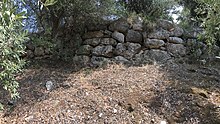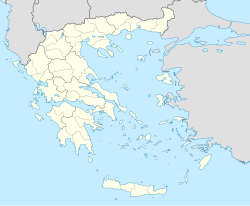Antron (Ancient Greek: Ἀντρών)[1][2] or Antrones (Ἀντρῶνες)[3] was a town and polis (city-state)[4] of ancient Thessaly in the district Achaea Phthiotis, at the entrance of the Maliac Gulf, and opposite Oreus in Euboea. It is mentioned in the Catalogue of Ships in the Iliad as one of the cities of Protesilaus,[1] and also in the Homeric hymn to Demeter as under the protection of that goddess. It was purchased by Philip II of Macedon,[3] and was taken by the Romans in their war with Perseus of Macedon.[5] It probably owed its long existence to the composition of its rocks, which furnished some of the best millstones in Greece; hence the epithet of πετρήεις ("maritime") given to it in the hymn to Demeter. Off Antron was a sunken rock (ἕρμα ὔφαλον) called the Ὄνος Ἀντρῶνος, or mill-stone of Antron.[6]
Ἀντρών | |
 The fortifications of Antron. | |
| Alternative name | Fanos |
|---|---|
| Location | Fanos, Glyfa, Stylida |
| Region | Phthiotis, Greece |
| Coordinates | 38°58′18″N 23°00′08″E / 38.971760299024794°N 23.002169361643908°E |
| Type | Ancient city |
| History | |
| Founded | Bronze Age |
| Abandoned | Roman period |
| Cultures | Ancient Greece |
| Satellite of | Achaea Phthiotis |
Modern scholars identify the location of Antron with the modern village of Glyfa.[7][8]
References
edit- ^ a b Homer. Iliad. Vol. 2.697.
- ^ Strabo. Geographica. Vol. p. 435. Page numbers refer to those of Isaac Casaubon's edition.
- ^ a b Demosthenes Phil. iv. p. 133, Reiske.
- ^ Mogens Herman Hansen & Thomas Heine Nielsen (2004). "Thessaly and Adjacent Regions". An inventory of archaic and classical poleis. New York: Oxford University Press. p. 713. ISBN 0-19-814099-1.
- ^ Livy. Ab urbe condita Libri [History of Rome]. Vol. 42.42, 67.
- ^ Strabo. Geographica. Vol. IX.5.8, IX.5.14. Page numbers refer to those of Isaac Casaubon's edition.
- ^ Richard Talbert, ed. (2000). Barrington Atlas of the Greek and Roman World. Princeton University Press. p. 55, and directory notes accompanying. ISBN 978-0-691-03169-9.
- ^ Lund University. Digital Atlas of the Roman Empire.
This article incorporates text from a publication now in the public domain: Smith, William, ed. (1854–1857). "Antron". Dictionary of Greek and Roman Geography. London: John Murray.
